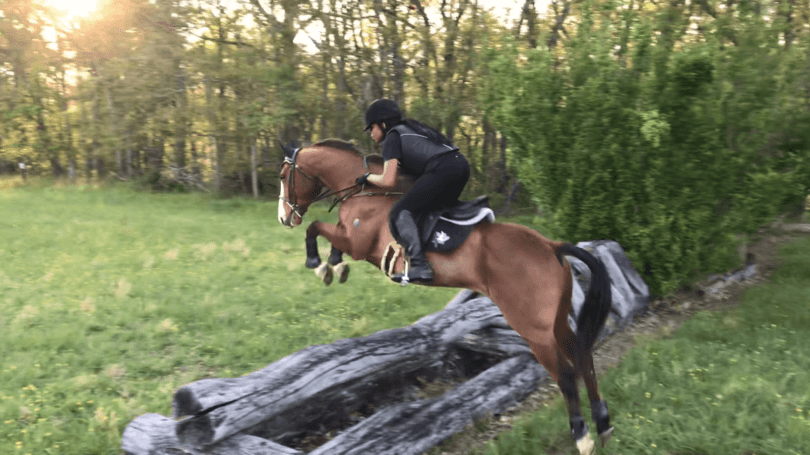The better your position, the better your jump.
Jumping is arguably one of the most exhilarating and fun equestrian disciplines. To do it well, however, you need to have the correct position before, during, and after each fence.
The “fold” refers to one of the motions critical to the mechanics of a rider’s jumping position (i.e. two-point position).
It’s also one of the more difficult things to learn while jumping.
Thanks to Sarah Harris for our featured photo!
Folding 101
Folding is part of the rider’s position over the fence, specifically the moment when the hip angle closes over the jump. It does not refer to the rider’s upper body pitching forward. (Avoid that!)
While riding on the flat (i.e. not jumping), and even in the two-point position, the angle of the hip should be more open.
Rider on the flat; hip angle is open
Learn more about the correct jumping position for horse riders.
Rider in a 2-point position; hip angle is still open
As the horse rises up beneath the rider over a fence, the rider’s leg absorbs the motion, and the hip angle gets smaller, or closes.
Folding should be a fluid movement, driven more by the horse’s motion over the fence rather than the rider actively changing position.
New to the sport? Check out our horse jumping glossary to learn the lingo.
Move With Your Horse
It’s important to note that the hip angle closes (or folds) as the horse rises up beneath the rider over the fence. To properly execute this motion, the rider must move with the horse.
Simply leaning farther forward over the horses’ neck puts the rider ahead of the motion of the horse. This will throw the rider out of balance over the fence and could unseat her upon landing.
New to the sport? Check out our 26-Page Horse Rookie’s Guide to Jumping.
On the opposite end of the spectrum, if the rider’s hip doesn’t close, the landing may pop the rider out of the saddle. This version of events would mean the rider was sitting too far back and is behind the motion of the horse.
Learning to fold correctly is about moving with the horse; as his front legs lift for the jump, his neck and back comes up towards the rider.
A rider in the proper jumping position will naturally close the hip as the horse’s body comes up and towards the rider.1
Rider over a large fence; the hip has closed or folded with the horse’s motion
Learn more about hip angles in this article from Practical Horseman.
Avoid Over-Jumping
The degree of fold depends on the size and aspects of the individual jump.
A common rookie mistake is overdoing the fold, or “over-jumping.”
This can be caused by getting into the jumping position too early, exaggerating the fold angle, and putting the rider too far out of the saddle and forward over the horses’ neck and shoulders.
If the jump is small, you don’t have to fold as much — or at all. (Although 10-year-old me insisted on folding over even a 12” crossrail.) For smaller jumps, the rider should simply open the elbow angle, giving the horse more rein to stretch his neck as he arcs over the obstacle.
A two-point position is sufficient when jumping smaller obstacles, such as those under 2’6” to 3’; very little fold is needed.
The fold only comes into play over larger obstacles, although the spread (i.e. horizontal distance) and location of the jump may also influence the amount of fold required2.
Your gear influences your ability to have the proper position. Check out the 10 Best Stirrups for Jumping.
Practice Makes Progress
If you have a tendency to over-jump, have a friend or trainer video your position over fences so you can evaluate your hip angle and timing. Then, repeat the exercise and consciously wait a few moments longer before getting into your jumping position.
You must train your brain and body to wait for the jump2.
If you’re jumping bigger fences, the motion of the horse almost forces the rider’s hip angle to close more, therefore creating more fold1.
Perfecting your fold takes practice, but learning to stay in time with your horse is a critical part of the jumping process.
P.S. Enjoy this article? Trot on over to:
- 10 Best Stirrups for Jumping Clear (And Staying Safe)
- What is the correct jumping position for horse riders?
- Compositi Stirrups Review: I’ve Never Jumped Better
- 12 Pointers for Jumping Crossrails with Confidence
- 100+ Things to Pack for a Jumping Horse Show (Checklist)
- How Often to Replace Horseback Riding Helmets
Sources:
- https://www.fei.org/stories/improve-your-jumping-position-these-four-steps
- https://stridesforsuccess.com/episode1031/
Further Reading:
- https://en.wikipedia.org/wiki/Jumping_position
- https://www.yourhorse.co.uk/advice/improve-your-riding/articles/how-to-perfect-your-approach-and-position-for-show-jumping
- https://practicalhorsemanmag.com/training/points-to-consider-jump-with-the-motion-of-your-horse-11824
- https://practicalhorsemanmag.com/training/geometry-rider-angles-30010
